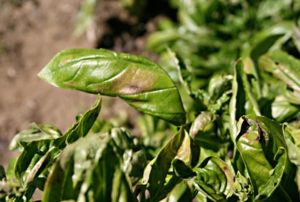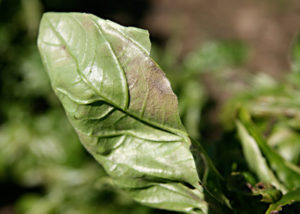 |
| Basil downy mildew on the upper surface of a leaf. Photo by Eric Sideman. |
 |
| And on the lower leaf surface. Photo by Eric Sideman. |
By Eric Sideman, Ph.D.
This winter I have been lecturing at organic growers’ meetings about new and emerging insects and diseases. I don’t know if the weather, the climate or some other factor is to blame, but for the first time I am hearing about enough previously unheard-of problems to fill an entire hour of discussion.
One of these new problems is basil downy mildew – a difficult disease to discuss because I have no good solution for it. Still, I want to highlight it, because last summer I received many calls about the mystery of basil dying midseason.
Basil downy mildew is a new disease to our region, and it seems to be here to stay. In the 20th century it was generally confined to African countries. It seems to have been spreading faster in the last decade. In 2007 it was first reported in the United States in south Florida. By 2008 it was in the Northeast, in Pennsylvania, New Jersey, New York and Massachusetts. Last year was the first year I saw it on most farms I visited in Maine.
The first symptom that catches your eye appears as bands of burned yellow on some leaves. The bands are there because at first the major veins in the leaves block the spread of the pathogen. Eventually the yellowing spreads over the leaf, more leaves become infected, and the plant looks like it has been stressed by heat or a nutrient deficiency. The symptom that shows that basil downy mildew is a disease caused by a pathogen is sporulation on the lower leaf surface. Downy mildews send out the spore-producing branches of mycelia through leaf stomata (pores in the epidermis), and patches of violet-gray sporangia (spore-producing structures) form. (See photos.) If your basil begins to look sick, flip over a leaf and look for downy patches. Vast numbers of sporangia are produced under cool, moist conditions, and the disease spreads very quickly.
The pathogen responsible is Peronospora belbahrii. Other species of Peronospora cause downy mildew in many other plants, including spinach, strawberries, crucifers and onions. A different but related genus causes downy mildew of lettuce. All grow as mycelia between plant cells. They reproduce asexually by sending out sporangiophores from stomata. Sexual reproduction results in a resting spore (oospore), which is very tolerant of cold, hot, dry and wet conditions and can persist in soil for years. Sexual reproduction requires the presence of two mating types. Only one mating type of the basil downy mildew pathogen seems to exist in Maine now, so asexual reproduction via sporangia protruding from leaves seems to account for the spread of the disease here.
The basil downy mildew pathogen is an obligate parasite, which means it can live only in living tissue (similar to the pathogen that causes late blight). Since it does not seem to produce resting spores in Maine, and all basil dies during our winters, how does it spread? During the growing season it is dispersed via airborne spores, but how did it get here to begin with, and how does it get here each year? It is always present in warm climates such as Florida or California. The pathogen can be seedborne and so be unknowingly distributed by contaminated seed. It may also spread by marketing infected basil leaves or plants from a warm region or from another country. Most likely it has spread throughout the eastern U.S. every summer since 2008 by wind-dispersed spores moving north following the warm weather. Since basil downy mildew affects many ornamental types of basil as well as those grown as culinary herbs, it can spread even faster once gardens get going.
Monitoring
In 2009 Cornell University started collecting information on basil downy mildew occurrences, to try to determine whether the pathogen could move northward through the eastern U.S., now that it is considered established in Florida. Cornell also thought a monitoring program may help growers prepare for downy mildew in their basil crop. Monitoring can also help determine whether seed is becoming a less important source of the pathogen, as expected. Each year Cornell creates a spreadsheet at https://vegetablemdonline.ppath.cornell.edu/NewsArticles/BasilDowny.html that is accessible to anyone. Growers and gardeners report the date and location of basil downy mildew occurrences and often include information about management experiences, adding to knowledge about this disease and helping develop a forecasting program.
Management
Research determining how to manage basil downy mildew is in the early stages. Different varieties and species of basil differ in susceptibility, but all the commonly grown sweet basil (Ocimum basilicum) is very susceptible. Less susceptible include lemon, Thai, spice and red types. Since these all look and taste different than the sweet herb basil, the challenge in breeding for resistance to basil downy mildew is to develop improved resistant varieties that still look, taste, grow and pack-out as a traditional, quality sweet basil. Progress is being made, but until resistant varieties are available, growers need alternative strategies to control downy mildew in sweet basil.
Minimizing leaf wetness and reducing humidity to obtain conditions unfavorable for disease development may suppress downy mildew, especially in greenhouses. Anything you can do to keep leaves dry, and to dry leaves quickly if they get wet, will help slow the spread. While effective, treating basil seed with hot water is problematic because the seed exudes a gel.
Plenty of fungicides are approved for organic production. Actinovate AG (active ingredient, Streptomyces lydicus), Double Nickel 55 (Bacillus amyloliquefaciens), MilStop (potassium bicarbonate), Regalia (extract of Reynoutria sachalinensis), Trilogy (neem oil) and OxiDate (hydrogen dioxide) are OMRI-listed fungicides labeled for use on herbs and for suppressing foliar diseases, including downy mildew. MilStop, Regalia and OxiDate are labeled for use outdoors and in greenhouses. The Actinovate, Double Nickel and Trilogy labels do not have a statement prohibiting use in greenhouses and so can be used. The Double Nickel label has directions for greenhouse use for soilborne pathogens. In a 2011 study, products with the most consistent control were MilStop and OxiDate – but even in this study the disease was not stopped; it was only reduced about 50 percent compared with the control. The challenge of controlling downy mildew is the need for blemish-free herbs when marketed as fresh sprigs – when a 50 percent reduction in symptoms is not enough. Additionally, infection occurs on the underside of leaves, a difficult area to reach with a fungicide, especially for sweet basil, as leaves often cup downward. I don’t believe fungicides are the answer.
According to one research report (1), this pathogen sporulates only when infected plants are incubated for at least 7.5 hours in the dark in a moisture-saturated atmosphere at 10 to 27 C (50 to 81 F). Keeping plants in the light has been shown to prevent production and quantity of spores within a crop, so light should slow disease development greatly. This pathogen sporulates profusely, so tremendously more spores can come from an affected crop than the amount that blows in from another crop. Keeping lights on overnight should help reduce humidity as well, which should provide additional control. Meg McGrath at Cornell University thinks testing this control method, at least in a research setting, is worthwhile; she is interested in working with growers who may want to try this. If interested, contact me; I can email this research article and put you in touch with Meg.
I think the best bet for now is to routinely check the online spreadsheet to determine when downy mildew is occurring on basil in your region, and, most important, to regularly inspect your crop for symptoms. Harvesting early is the best defense I can offer now – so plant succession crops. If you see downy mildew in your crop, pull and destroy that planting. Ideally, later plantings will mature when spores are not blowing around and conditions do not favor spread of the disease.
Eric is MOFGA’s organic crop specialist. You can reach him at 568-4142 or [email protected].
Thanks to Meg McGrath for a lot of the information in this article.
1. Yigal Cohen, Moshe Vaknin, Yariv Ben-Nalm and Avia Rubin, 2013. Light Suppresses Sporulation and Epidemics of Peronospora belbahrii. PLOS ONE 8:11:e81282, www.plosone.org
